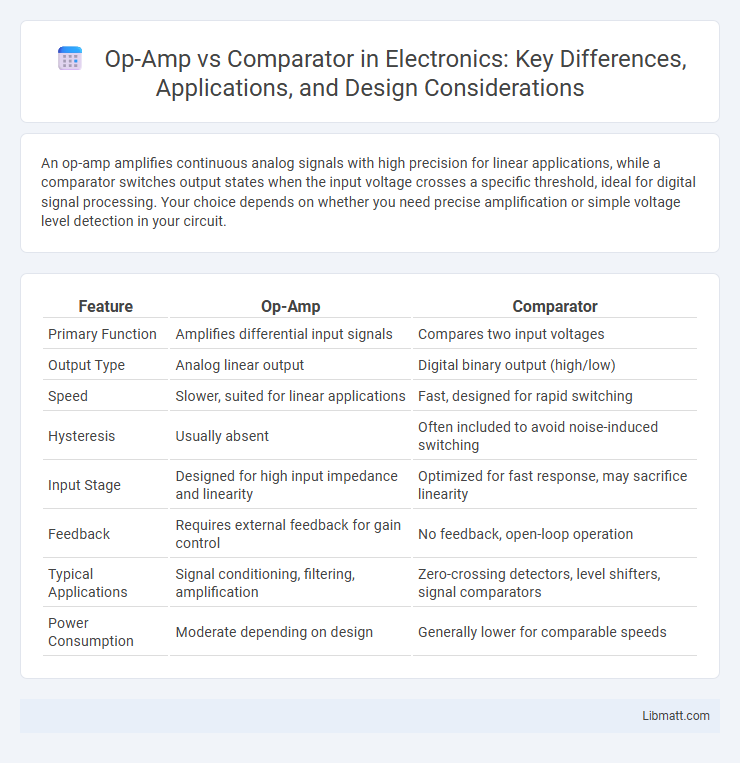An op-amp amplifies continuous analog signals with high precision for linear applications, while a comparator switches output states when the input voltage crosses a specific threshold, ideal for digital signal processing. Your choice depends on whether you need precise amplification or simple voltage level detection in your circuit.
Table of Comparison
| Feature | Op-Amp | Comparator |
|---|---|---|
| Primary Function | Amplifies differential input signals | Compares two input voltages |
| Output Type | Analog linear output | Digital binary output (high/low) |
| Speed | Slower, suited for linear applications | Fast, designed for rapid switching |
| Hysteresis | Usually absent | Often included to avoid noise-induced switching |
| Input Stage | Designed for high input impedance and linearity | Optimized for fast response, may sacrifice linearity |
| Feedback | Requires external feedback for gain control | No feedback, open-loop operation |
| Typical Applications | Signal conditioning, filtering, amplification | Zero-crossing detectors, level shifters, signal comparators |
| Power Consumption | Moderate depending on design | Generally lower for comparable speeds |
Introduction to Op-amp and Comparator
Op-amps (operational amplifiers) are versatile analog components designed to amplify voltage differences with high gain and linearity, widely used in signal conditioning, filtering, and mathematical operations. Comparators, in contrast, are specialized devices that compare two voltages and output a digital signal indicating which input is higher, commonly implemented in zero-crossing detectors and threshold detection circuits. Understanding the fundamental purpose and application of your op-amp or comparator ensures optimal circuit design tailored to amplification or binary decision tasks.
Fundamental Differences Between Op-amp and Comparator
Op-amps and comparators differ fundamentally in their intended applications and internal design; op-amps are designed for linear amplification with high gain and bandwidth, supporting feedback for precise analog signal processing, while comparators are optimized for fast switching between output states to detect voltage thresholds without the need for feedback. Op-amps operate primarily with continuous output voltage within an analog range, whereas comparators provide discrete output levels, representing binary decision-making in circuits. The input stage of comparators is configured to tolerate faster transitions and higher slew rates, whereas op-amps focus on stability and minimal distortion in linear operation.
Working Principle of Op-amp
An operational amplifier (Op-amp) amplifies the voltage difference between its inverting and non-inverting inputs to produce a proportional output voltage, operating in a linear region for analog signal processing. It uses negative feedback to control gain and stabilize the output, enabling precise amplification of small differential signals. The high input impedance and low output impedance characteristics of op-amps facilitate accurate and efficient signal amplification in a wide variety of electronic circuits.
Working Principle of Comparator
A comparator operates by continuously comparing two input voltages and switching its output to indicate which input is higher, functioning as a binary decision device. Unlike op-amps used for amplification, comparators have a high-speed response ideal for converting analog signals into digital signals by providing a clear, saturated output voltage corresponding to the input conditions. Your circuit relies on the comparator's open-loop configuration to swiftly detect voltage thresholds without feedback, enabling precise voltage level detection in applications like zero-crossing detectors and pulse-width modulation.
Key Applications of Op-amps
Op-amps are essential in signal amplification, filtering, and analog computation, making them ideal for precise audio processing, sensor interfacing, and instrumentation systems. They enable your circuits to achieve high gain and stability in analog signal conditioning, such as voltage amplification and active filtering. Unlike comparators, op-amps are widely used in linear applications requiring continuous output control.
Key Applications of Comparators
Comparators are essential in applications requiring precise voltage level detection, such as zero-crossing detectors, pulse width modulation (PWM) circuits, and analog-to-digital converters (ADCs). Their ability to quickly switch output states based on input voltage thresholds makes them ideal for implementating overvoltage protection and window detector circuits in power management systems. You can rely on comparators for accurate decision-making tasks in digital logic interfacing and signal conditioning.
Input and Output Characteristics Comparison
Op-amps feature differential inputs with high input impedance and typically produce a continuous, linear output voltage proportional to the input difference, making them ideal for amplification tasks. Comparators also have differential inputs but operate with a distinct output characteristic, switching rapidly between saturation levels to represent a binary state, useful for threshold detection. Your choice depends on whether you need precise analog signal amplification or fast digital-level decision-making based on input voltage comparisons.
Design Considerations: Op-amp vs Comparator
Design considerations for op-amps versus comparators center on their input stage architecture and output stage functionality; op-amps feature linear, high-gain differential inputs optimized for amplification with feedback, while comparators have high-speed input stages designed to detect voltage thresholds without linear operation. Op-amps prioritize minimal offset voltage and slew rate control to ensure signal fidelity, whereas comparators emphasize rapid switching speed and hysteresis to prevent output oscillations around the threshold. Power consumption and input common-mode voltage range also influence the selection, with comparators often favoring lower power and wider input ranges for fast response in digital circuits.
Common Mistakes in Circuit Selection
Confusing the operational amplifier's linear gain properties with the comparator's fast switching behavior often leads to incorrect circuit selection. Designers frequently misuse op-amps in threshold detection applications where comparators provide faster and more reliable digital output signals. Overlooking input offset voltages and response time differences causes performance degradation and erratic behavior in precision sensing and switching circuits.
Summary: Choosing Between Op-amp and Comparator
Op-amps excel in linear signal amplification with high input impedance and stable feedback control, making them ideal for analog signal conditioning. Comparators are designed for fast, precise voltage level detection with sharp output transitions in digital interfacing and threshold detection. Selecting between the two depends on application needs: use op-amps for continuous analog processing and comparators for binary decision-making tasks.
Op-amp vs Comparator Infographic

 libmatt.com
libmatt.com